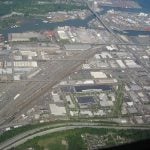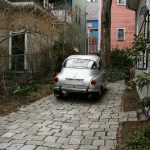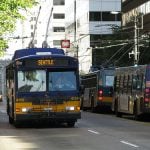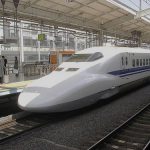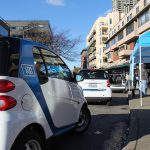How San Francisco & other ped-friendly cities are expanding sidewalks
The lunar New Year yesterday brought attention to an issue plaguing San Francisco’s crowded Chinatown: overflowing sidewalks. As the San Francisco Chronicle reported, city officials are working with Chinatown business owners to develop a plan to add much-needed space for pedestrians. “The challenge is that when you change one thing, there’s a ripple effect,” recently appointed Supervisor Julie Christensen, explained to the Chronicle. “Even if you can’t afford to implement a whole plan, it’s important to have that whole plan.”
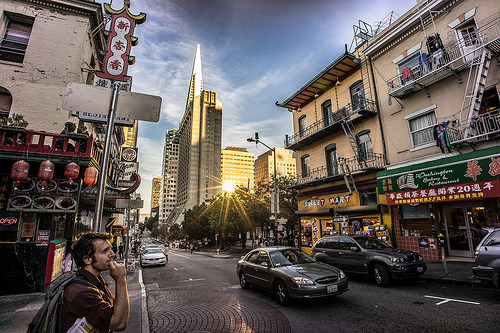
Image from Giuseppe Milo.
Consider Stockton Street, the main thoroughfare in Chinatown, which has 10-foot-wide sidewalks, and is “already are challenged by the many small shops, groceries and produce markets that push their tables and bins out front, claiming precious space supposedly reserved for walkers.” Parking is largely banned on the street during the two weeks before the New Year’s celebration in order to accommodate temporary retail stalls. Even on non-holidays, sometimes there can be “blocks-long gridlock of foot traffic,” reports the Chronicle.
“The sidewalks are so narrow, people get forced into the street,” Pius Lee, chairman of the Chinatown Neighborhood Association, told the Chronicle. “They simply need to be wider so people can walk safely.” Lee suggests getting rid of one of the three traffic lanes that enter and exit the Stockton Street Tunnel, so that the sidewalks can be expanded without wiping out any of the street parking, which business owners fear would negatively impact business.
But it might not be that simple, according to Supervisor Christensen. “We’re not just talking about wider sidewalks, but about Muni routes, traffic patterns, parking and a lot of other things.” She is advocating for a plan that incorporates existing planned projects such as an under-construction subway station.
The Stockton Street sidewalk expands to 15 feet once it crosses Broadway toward North Beach, and the pedestrian traffic eases there, too. Elsewhere in San Francisco, sidewalk improvements have resulted in other benefits; for example, an $8.3 million project gave Castro Street between Market St. and 19th St. new trees, upgraded lighting, bike racks and new benches.
You might say sidewalk expansion is in vogue, thanks to grant money provided by federal government agencies including the Federal Highway Administration and the Federal Transit Administration. As many communities move towards a more pedestrian-friendly model by investing in public transit, bike accommodations and pedestrian zones, sidewalks are newly appreciated for their role in facilitating both a sense of community and supporting local business.
Take Waco, Texas, for example, which has a $32.8 million transit strategy that allows for building or repairing 141 miles of sidewalk, with 98 miles of new pavement in the next 10 years. Pedestrian-friendly infrastructure was largely heralded by the peds–and their advocates: The city’s Metropolitan Planning Organization “received significant feedback on a lack of pedestrian routes in the region. As a result, the Waco City Council has ventured on its most ambitious pedestrian initiative. The city is already spending around $200,000 annually on sidewalk projects to keep up with demand and new requirements,” according to EfficientGov.
Then there’s Lakewood, Washington, which will devote over $800,000 in federal grants to installing curb gutter and sidewalks, and Oakland City, Indiana, which will also use $600,000 in federal grant funds to replace old sidewalks and build new ones downtown.
Not only are sidewalks receiving a makeover, they are also undergoing an environmentally friendly upgrade: modern materials, like flexible rubber salvaged from recycled plastic and old tires, is cheaper and longer-lasting than traditional concrete, which is expensive to repair and prone to swells and cracks. Santa Monica, California is an early adopter, and boasts rubber sidewalks, with 20,000 square feet installed since 2000. Other popular features include heated sidewalks, such as those installed in Chicago beginning in the 1970s, which, while pricey, are designed to melt snow and ice, and glow-in-the-dark sidewalks and paths.
Learn more about the grants available for improving sidewalk construction or replacement as well as general upgrades for pedestrians. Check out the FHA’s Transportation, Community and System Preservation Program (targeting transportation-related plans and increased access to employment and commercial areas), the FTA’s Transit-Oriented Development (aimed at developing mixed-use resources located near transit facilities) and the FHA’s Transportation Enhancement Activity grants, which focus on improving transit experiences via pedestrian and biking infrastructure, pedestrian safety programs, and other initiatives.
Related Posts
Category: Infrastructure, municipal











